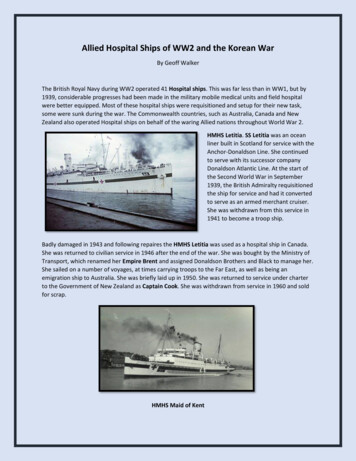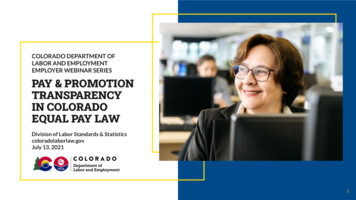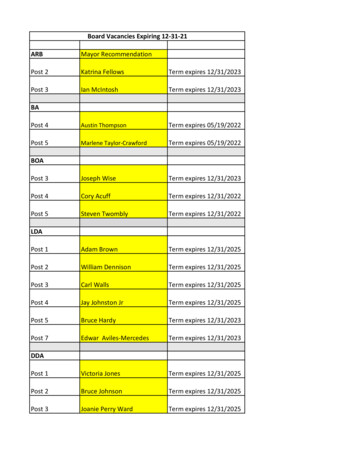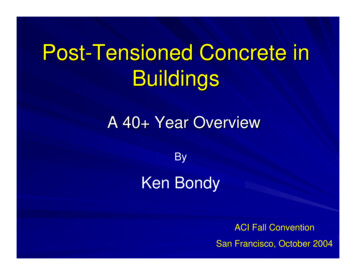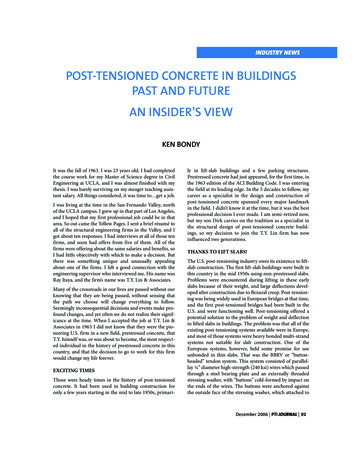
Transcription
Post WW2,1950sAmerica, and theCivil RightsMovement
Economics after WW2 People worry about return to depression Initial years after WW2 GNP slumped Price controls relaxed – prices skyrocket,inflation Epidemic of strikes Government reinstitutes controls Unions lose power – Taft-Hartley Act Outlaws closed shops Union membership begins to decline
Economics after WW2 Economy recovers – why? Cheap energy – low cost of petroleum Productivity cold war spending, marshall plan 1950-1970 long economic boom National income doubles in 1950s and againin 1960s Middle class doubles Agribusiness - mechanization
GI Bill of 1944 15 million returning veterans Encourage veterans to get aneducation Unemployment benefits Loans for homes, farms, businesses
Elections 1948 – Truman v. Dewey v. Thurmond Truman-- Whistlestop campaign – country widetrain campaign against “do nothing congress” Thurmond – Dixiecrat (anti-civil rights, prostates’rights) Thomas Dewey – Republican (gov. of NY) 1952 - Eisenhower (R) v. Stevenson (D) Eisenhower – middle of the road approach Pledged to personally go to Korea to end war Nixon’s checker’s speech
Eisenhower TV – commercialized campaign Modern Republicanism – middle road Conservative with money Liberal with people Raised minimum wage, extended Soc.Sec., public housing, etc.
Video Clips I Like Ike! http://www.youtube.com/watch?v va5Btg4kkUE Checkers Speech (start at 3 min) http://www.youtube.com/watch?v S4UEvjjPL0
Prosperity of 1950s/1960s Result of colossal military budget, govtfunded high tech industry, and R and D Cheap energy – US controlled oil Highways, air conditioners, etc. Higher productivity – better educated andbetter equipped Increased standard of living Agribusiness – mechanized farming More workers shift to industry/white collar Middle Class doubles to 60% of pop’n Own cars, TVs, washing machines
Suburban Living FHA/VA low interest loansTax deductions for mortgage payers1956 Interstate Highway ActBy 1960, 25% of Americans live in suburbs By 2000, the percentage goes up to 50% White Flight – Middle Class white Americans left the cities Moved to the suburbs Cities lose income Poor suffers – education, police, fire
Suburban Living The American Dream 1949 William Levitt produced 150 houses perweek. Standardized plans, factory assembled frames 7,990 or 60/month with no down payment.
Consumerism 1950 Introduction of the Diner’s Card Modern advertising
Baby Boom It seems to me that every other younghousewife I see is pregnant.-- British visitor to America, 1958 1957 1 baby born every 7 seconds Largest generation in US history Increase in school enrollments, cannedfood. Leads to a youth culture
Baby Boom
Teen Culture In the 1950s the word “teenager” enteredthe American language. 1951 “race music” “ROCK ‘N ROLL” roots lay mainly in rhythm and blues, country, folk,gospel, and jazz “Juvenile Delinquency”
Teen Culture The “Beat” Generation: rejection of mainstream American values celebrated non-conformity and spontaneouscreativity Jack Kerouac On The Road Allen Ginsberg poem, “Howl” Neal Cassady William S. Burroughs
A Changing Workplace Automation: 1947-1957 factory workers decreased by 4.3%,eliminating 1.5 million blue-collar jobs. By 1956 more white-collar than blue-collarjobs in the U. S. Computers Mark I (1944). First IBMmainframe computer (1951). Corporate Consolidation: By 1960 600 corporations (1/2% of all U. S.companies) accounted for 53% of total corporateincome. WHY? Cold War military buildup.
A Changing Workplace New Corporate Culture:“The Company Man” 1956 Sloan Wilson’s The Man inthe Gray Flannel Suit Women lose factory jobs in the post warperiod, but gain service sector jobs “pink collar” sector – secretarial work Pop culture still glorifies the housewife and thecult of domesticity Betty Friedan and NOW reject this image Feminine Mystique
Well-Defined Gender RolesThe ideal modern woman married, cooked andcared for her family, and kept herself busy byjoining the local PTA and leading a troop ofCampfire Girls. She entertained guests in herfamily’s suburban house and worked out on thetrampoline to keep her size 12 figure.-- Life magazine, 1956The ideal 1950s man was the provider, protector,and the boss of the house. -- Life magazine,1955
The Culture of the Car Car registrations: 1945 25,000,0001960 60,000,000 2-family cars doubles from 1951-1958 1956 Interstate Highway Act largestpublic works project in Americanhistory! Cost 32 billion. 41,000 miles of new highways built.
The Culture of the Car America became a more homogeneousnation because of the automobile.
The Culture of the Car The U. S. population was on the move inthe 1950s. NE & Mid-W S & SW (“Sunbelt” states) 1955 Disneyland opened in SouthernCalifornia. (40% of the guests came from outsideCalifornia, most by car.)
Television 1946 7,000 TV sets in the U. S.1950 50,000,000 TV sets in the U. S. Mass Audience TV celebratedtraditional American values. “Television is a vast wasteland.” Newton Minnow, Chairman of theFederal Communications Commission,1961
Television in the 1950s and 1960s Leave It to Beaver1957-1963 Father Knows Best 1954-1958 The Ozzie & Harriet Show1952-1966
Religious Revival Church membership: 1940 64,000,0001960 114,000,000 Television Preachers: 1. Catholic Bishop Fulton J. Sheen “Life isWorth Living” 2. Methodist Minister Norman Vincent Peale The Power of Positive Thinking 3. Reverend Billy Graham ecumenicalmessage; warned against the evils ofCommunism.
Progress Through Science 1951 -- First IBM Mainframe Computer1952 -- Hydrogen Bomb Test1953 -- DNA Structure Discovered1954 -- Salk Vaccine Tested for Polio1957 -- First Commercial U. S. NuclearPower Plant 1958 -- NASA Created 1959 -- Press Conference of the First 7American Astronauts
The 50s Come to a Close 1959 Nixon-Khrushchev “Kitchen Debate” An entire house was built that the Americanexhibitors claimed anyone in America couldafford. It was filled with labor saving andrecreational devices meant to represent the fruitsof the capitalist American consumer market.
Civil Rights Movement – post WW2through 1960s Civil Rights Act of 1875 -- Outlawed segregation Supreme Court overturned it in 1883 Plessy v. Ferguson “separate but equal” did not violate the 14th amendment(equal treatment) Allowed Southern states to pass Jim Crow laws (separatingthe races) Allowed restrictions on inter-race contact WW2 set the stage for the civil rights movement Opened new job opportunities One million African Americans served Came home and fought to end discrimination During the war, civil rights organizations fought for votingrights and challenged Jim Crow laws Truman ends segregation in civil service, armed forces
Civil Rights Movement Campaign led by the NAACP Focused on inequality between separate schools thatstates provided Thurgood Marshall argued many of these cases 1950 – Sweatt v. Painter Separate professional schools are not equal 1954 - Brown v. Board of Education of Topeka Marshall’s most stunning victory Supreme Court struck down segregation in public schoolsas a violation of 14th amendment 2nd case - To be implemented “with all deliberate speed”
Civil Rights Movement 1955 – Montgomery Bus Boycott African Americans were impatient with the slow speed of change Took direct action 1955 – Rosa Parks refused to give up her seat and wasarrested JoAnn Robinson suggested a boycott of the buses Leaders of the African American community formed theMontgomery Improvement Association (MIA) Elected 26 yr old Martin Luther King to lead Dr. King made a passionate speech and filled the audience witha sense of mission African Americans boycotted the buses for 381 days and filed alawsuit Organized car pools Walked long distances 1956 – Supreme Court outlawed bus segregation
Civil Rights Movement 1957 – Little Rock 9 - State had beenplanning for desegregation Governor Faubus ordered the National Guard toturn away the “Little Rock Nine” the 9 African American students who wouldintegrate Little Rock Central High A Federal judge ordered Faubus to let thestudents attend the school Eisenhower placed the National Guard underfederal control to watch the 9 attend school A year later, Faubus shut down the high school
Civil Rights Movement Civil Rights Act – 1957 Establishes Civil Rights Commission to investigateviolations 1957 – Southern Christian LeadershipConference established (SCLS) Mobilize black churches for civil rights 1960 – Student Non-violent CoordinatingCommittee (SNCC) formed 1960 – Sit-in movement – focus on segregatedlunch counters 1st – Greensboro, NC
Civil Rights Movement Freedom Riders Civil Rights activists would ride busses to testthe Supreme Court decision that bannedsegregation on buses and in bus terminals Provoking a violent reaction to force the JFKadministration to enforce the law Riders were tormented and beaten Newspaper coverage and the violence provokedJFK to send federal marshals to protect theriders Segregation in all interstate travel facilities wasbanned
Civil Rights Movement 1962 – Integrating Ole Miss Air Force Veteran James Meredith won a federalcourt case that allowed him to enroll in the all-whiteUniversity of Mississippi (Ole Miss) Governor Ross Barnett refused to let him register Kennedy ordered federal marshals to escortMeredith Riots broke out and resulted in 2 deaths Federal officials accompanied Meredith to class toprotect him
Civil Rights Movement Birmingham Strictly enforced its segregation Reputation for racial violence Reverend Shuttlesworth, MLK, and the SCLC tested theirnon-violence MLK and others were arrested during a nonviolentdemonstration MLK wrote Letters from a Birmingham Jail With MLK out of jail, the SCLC planned a children’s march inBirmingham Police Commissioner “Bull” Connor arrested them Later, the police met the marchers with high pressure fire hosesand attack dogs TV cameras captured the scene Birmingham officials finally ended segregation Convinced JFK to write a civil rights act
Civil Rights Movement 1963 - March on Washington To show support for JFK’s civil rights bill, a march onWashington was formed Aug. 28, 1963, 250,000 people assembled inWashington MLK gave his “I have a Dream” speech Appeals for peace and harmony Two weeks later, 4 girls were killed in a Birminghamchurch Two months later, JFK is assassinated LBJ pledges to carry out JFK’s work Passes Civil Rights Act of 1964 Prohibited discrimination Gave equal access to public accommodations
Civil Rights Movement 1964 – 24th Amendment – abolished poll tax 1964 – Freedom Summer - CORE and SNCC workedto register as many African-American voters aspossible – push for voting rights bill 1964 - SNCC organized the Mississippi FreedomDemocratic Party to give African Americans a politicalvoice Fannie Lou Hamer spoke at the Democratic NationalConvention in 1964 Support poured in for the MFDP Civil Rights leaders compromised with the DemocraticParty (MFDP got two seats in Congress)
Civil Rights Movement 1965 - SNCC led a voting rights campaign inSelma, Alabama After a demonstrator was shot, MLK organized a 50mile march to Montgomery Mayhem broke out and TV crews caught policebeating and gassing marchers Johnson presented a voting rights act and gavemarchers federal protection Voting Rights Act of 1965 – eliminates literacytests, allows federal officials to overseeregistration, voting * end of nonviolence *
Civil Rights Movement Malcolm X Began as militant black nationalistBlack separatismWent on Hajj, moved away from separatismAssassinated in 1965 Black Power Black Panther party Stokely Carmichael – leader of SNCC began to preach blackpower – 1966 Exercise political and economic rights to speed integration Emphasized their distinctiveness 1968 – MLK assassinated
Suburban Living FHA/VA low interest loans Tax deductions for mortgage payers 1956 Interstate Highway Act By 1960, 25% of Americans live in suburbs By 2000, the percentage goes up to 50% . --Life magazine, 1956 The ideal 1950s man was the provider, protector,
